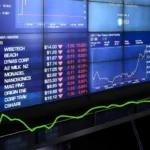Asian stocks kicked off the week positively, buoyed by Wall Street’s third consecutive winning week and the Nikkei 225 index reaching a 33-year high. While U.S. futures slightly declined, oil prices rose as investors turned their attention to upcoming OPEC plus meetings.
Japan’s Nikkei 225 initially broke its September peak, reaching a 33-year high, before closing at 33,414.87 with a 0.5% dip. The Hang Seng surged in Hong Kong by 1.5% to 17,717.60, and the Shanghai Composite index advanced by 0.5% to 3,070.22. China announced that it would maintain its benchmark lending rates unchanged, as expected, citing a weaker yuan and the need to assess the impact of recent stimulus measures on the economy.
South Korea’s Kospi rose by 1.1%, Australia’s S&P/ASX 200 edged 0.1% higher, while Taiwan’s Taiex and Bangkok’s SET experienced minor declines. Thailand’s economy reportedly grew slower than expected in the last quarter, primarily due to weakness in exports and agriculture, despite robust consumer spending and a recovering tourism sector. On Wall Street, the S&P 500 edged up 0.1% to 4,514.02, nearing its three-month high, while the Dow Jones Industrial Average inched up less than 0.1% to 34,947.28, and the Nasdaq composite gained 0.1% to 14,125.48.
Retailers played a vital role in the market movements, with several reporting better-than-expected results for the latest quarter. Gap surged 30.6%, exceeding Wall Street forecasts, while Ross Stores climbed 7.2%. However, BJ’s Wholesale Club fell 4.8% despite reporting better results, as its underlying sales figure fell short of expectations.
The positive sentiment in the market is driven by hopes of overall growth in S&P 500 companies for the first time in a year. Investors are also closely monitoring inflation trends, hoping for signs that the Federal Reserve may halt interest rate hikes. In the bond market, the yield on the 10-year Treasury slightly rose to 4.45% from 4.44% late Friday. The bond market has seen fluctuations recently, impacting stock prices.
Oil prices, a critical factor in inflation concerns, showed a modest recovery. U.S. crude for December delivery gained 54 cents to $76.58, while Brent crude, the international standard, rose 56 cents to $81.17 per barrel. Currency markets saw the U.S. dollar weakening against the Japanese yen, trading at 148.96 yen, down from 149.58 yen. Expectations of lower U.S. interest rates are likely driving this shift in currency dynamics.
Ongoing global economic conditions, central bank policies, and geopolitical developments will likely influence the market’s trajectory in the coming weeks.











